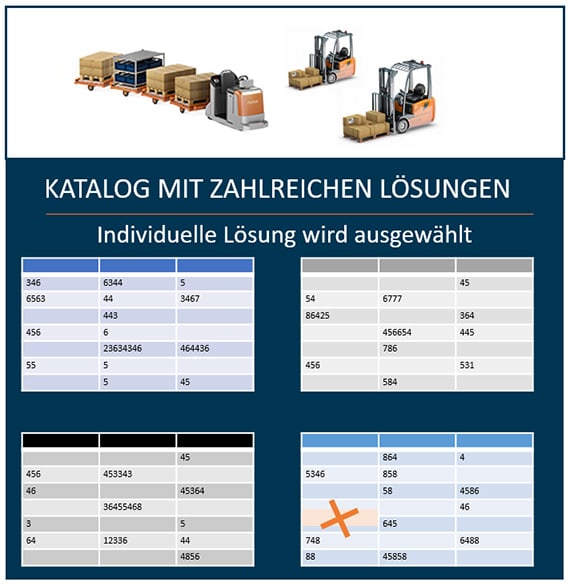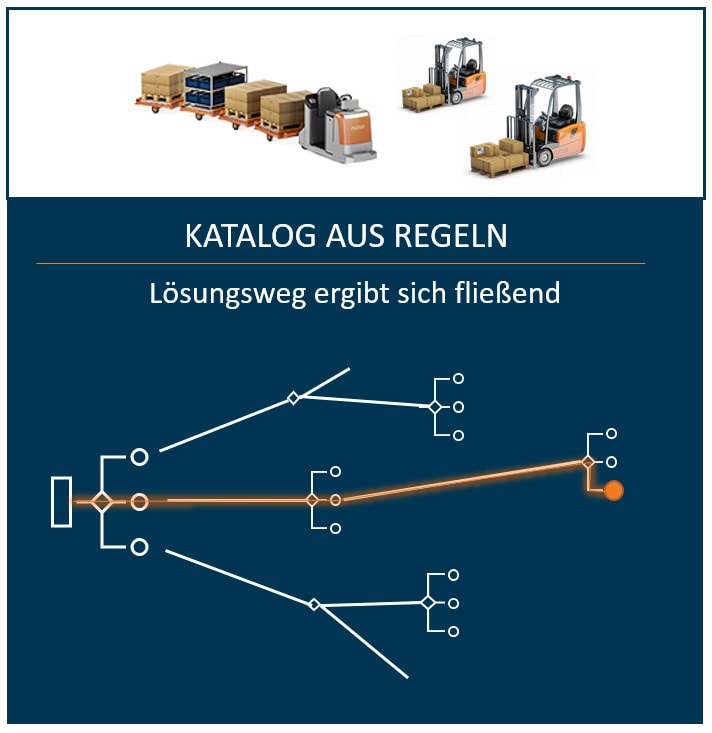Optimized trailer planning for tugger trains with SAP!
Scenarios for the loading sequence of tugger trains and forklifts
One of the central limiting factors in almost any logistics planning decision is the loading capacity of the vehicle. Any planned loading operation must be compared to this capacity. After all, it makes no sense to assign a forklift truck to transport three pallets at the same time if there is room for only one pallet on the forks. The planned solution must therefore know the transport capacity of the vehicle and, based on this, be able to simulate specific loading operations in order to identify and eliminate unrealizable requirements.
There is a number of approaches for this. In traditional forklift operation, it will usually suffice to have a simple instruction like “only one task at a time” with a list of forklift types that are used for transportation, since forklifts can often only pick up one load. Some trucks, however, can pick up more than one task at a time. Yet, with a towed train, the options for combining load capacities can reach a much higher level of sophistication.
Deductive loading check
Flexus AG has developed a solution for this which is based on the so-called trailer scheme. A network of tables has been developed in which the possible capacities can be set. A trailer scheme always consists of a fixed number of trailers which in turn consist of individual loading positions. These positions can then be assigned with loading profiles which define how many units of a certain type of load can be picked up at the same time. It is also possible here to have combinations of different load types. In many cases, however, the number of trailers that can be used is variable.
In order to take this into account, the trailer schemes can be combined into a group of trailer schemes. In this way, all possible loading options are stored in the tables. The optimization solution must then make sure that each vehicle, which is also found in the tables, is always in the loading condition. This is considered a deductive test because the evaluation of the current situation is not performed by the system itself but is read from an extensive solution catalog that was created in advance and has proven to be unrestrictedly valid.
Inductive loading check
In the current project, however, an alternative to this approach has been developed that completely abandons the principle of the trailer scheme and instead makes use of trailer rules. A decision graph is constructed for the loading operations, where each node in the graph represents the loaded carrier at the time of the check. A check is then run to see if the loaded medium can be attached to one of the existing leaf nodes. There is usually only one leaf node, otherwise there would be parallel rows of attachments. The test must now satisfy a number of specific rules. Such a rule can theoretically perform any conceivable test. For example, one rule specifies that certain load carrier types should not be attached to other types (heavy load carriers, for instance, should not be attached at the rear of light load carriers in order to maintain equilibrium).
Other rules limit the number of carriers of a certain type or even the maximum total number of carriers that can be connected. The load carrier types are grouped together here because many of them need to be handled in the same way. It is also possible to provide exceptions for each configured rule. This loading check type thus uses an inductive approach, as an overall estimate is derived from observed rules and patterns.
Comparison of loading checks
Which of these two approaches is better? A closer look at the advantages and disadvantages of both approaches will shed light on this question.
Trailer scheme – deductive check
Advantages:
- Can be implemented and modified by adaptation
- Complex combinations can be mapped easily
Disadvantages:
- Performance scales very poorly with an increasing number of combinations
- Maintenance effort increases tremendously with the number of combinations
- The sequence of loading operations cannot be verified
Trailer rules – inductive check
Advantages:
- Orientation directly based on customer requirements
- Low setup effort even with a large number of combinations
- Performance can be scaled even with a large number of combinations
- The load sequence can be verified
Disadvantages:
- New rules can only be defined in the coding
- Exceptions can only be defined and adapted during programming
- Customer requirements must be well-known


The comparison clearly shows that there is no undisputed winner. Both approaches come with advantages and disadvantages that vary depending on the problem situation. If there is only a small number of load carrier types or, most of all, only a modest number of possible combinations of these types, then the disadvantages of the trailer scheme in terms of effort and performance are not noticeable. As such, the advantage of not having to make any adaptations in the event of changes can be fully exploited. Beyond a certain level of complexity, however, this method is simply no longer efficient, both in terms of maintenance and performance. Making the switch from strictly individual solutions to coding is a necessary evil here to be able to guarantee reasonable runtimes and therefore make the use of the optimization solution possible in the first place.
As a result, it is important to assess for each project which of the two approaches is more appropriate for the situation at hand.

Author – Johannes Zott
AI Developer
Working at Flexus, he optimizes the intralogistics of our customers with appropriate optimization algorithms. The main application of this is in the optimization of forklifts, tugger train logics and the efficient control of AGVs.

